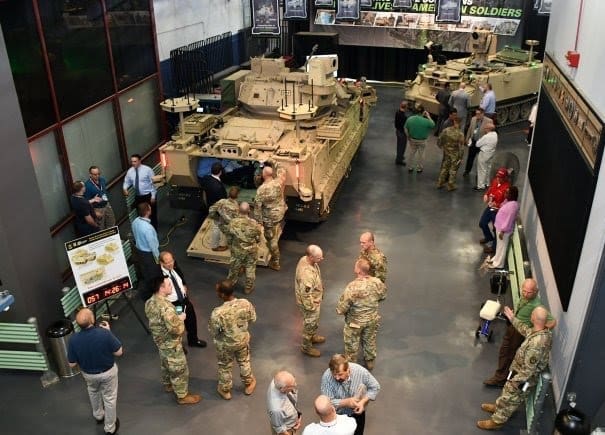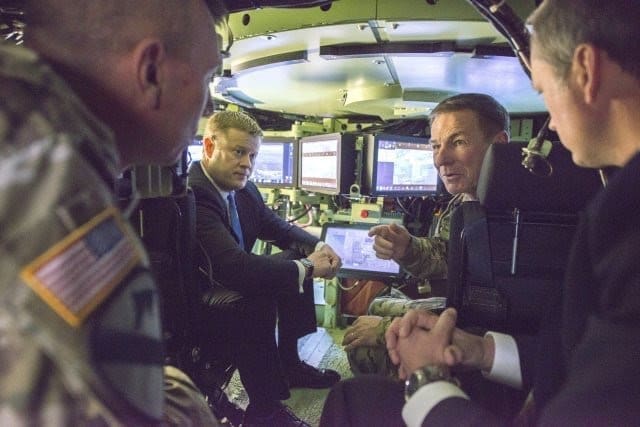Soldiers to operate armed robotic vehicles from upgraded Bradleys
AUSTIN, Texas — Soldiers are slated to fire at targets next year using a platoon of robotic combat vehicles they will control from the back of modified Bradley Fighting Vehicles.
The monthlong operational test is scheduled to begin in March at Fort Carson, Colorado, and will provide input to the Combat Capabilities Development Command’s Ground Vehicle Systems Center on where to go next with autonomous vehicles.
The upgraded Bradleys, called Mission Enabler Technologies-Demonstrators, or MET-Ds, have cutting-edge features such as a remote turret for the 25 mm main gun, 360-degree situational awareness cameras and enhanced crew stations with touchscreens.

Initial testing will include two MET-Ds and four robotic combat vehicles on M113 surrogate platforms. Each MET-D will have a driver and gunner as well as four Soldiers in its rear, who will conduct platoon-level maneuvers with two surrogate vehicles that fire 7.62 mm machine guns.
“We’ve never had Soldiers operate MET-Ds before,” said David Centeno Jr., chief of the center’s Emerging Capabilities Office. “We’re asking them to utilize the vehicles in a way that’s never been done before.”
After the tests, the center and Next-Generation Combat Vehicle Cross-Functional Team, both part of Army Futures Command, will then use Soldier feedback to improve the vehicles for future test phases.
“You learn a lot,” Centeno said at the International Armored Vehicles USA conference on June 26. “You learn how they use it. They may end up using it in ways we never even thought of.”
The vehicles are experimental prototypes and are not meant to be fielded, but could influence other programs of record by demonstrating technology derived from ongoing development efforts.
“This technology is not only to remain in the RCV portfolio, but also legacy efforts as well,” said Maj. Cory Wallace, robotic combat vehicle lead for the NGCV CFT.

One goal for the autonomous vehicles is to discover how to penetrate an adversary’s anti-access/aerial denial capabilities without putting Soldiers in danger.
The vehicles, Centeno said, will eventually have third-generation forward-looking infrared kits with a target range of at least 14 kilometers.
“You’re exposing forces to enemy fire, whether that be artillery, direct fire,” he said. “So, we have to find ways to penetrate that bubble, attrit their systems and allow for freedom of air and ground maneuver. These platforms buy us some of that, by giving us standoff.”
PHASE II, III
In late fiscal year 2021, Soldiers will again play a role in Phase II testing as the vehicles conduct company-level maneuvers.
This time, experiments are slated to incorporate six MET-Ds and the same four M113 surrogates, in addition to four light and four medium surrogate robotic combat vehicles, which industry will provide.
Before these tests, a light infantry unit plans to experiment with the RCV light surrogate vehicles in Eastern Europe next May.
“The intent of this is to see how an RCV light integrates into a light infantry formation and performs reconnaissance and security tasks as well as supports dismounted infantry operations,” Wallace said at the conference.
Soldier testing for Phase III is slated to take place mid-fiscal 2023 with the same number of MET-Ds and M113 surrogate vehicles, but will instead have four medium and four heavy purpose-built RCVs.
“This is the first demonstration which we will be out of the surrogate realm and fielding purpose builts,” Wallace said, adding the vehicles will conduct a combined arms breach.
The major said he was impressed with how quickly Soldiers learned to control the RCVs during the Robotic Combined Arms Breach Demonstration in May at the Yakima Training Center in Washington.
“Soldiers have demonstrated an intuitive ability to master controlling RCVs much faster than what we thought,” he said. “The feedback from the Soldiers was that after two days they felt comfortable operating the system.”
There are still ongoing efforts to offload some tasks in operating RVCs to artificial intelligence in order to reduce the cognitive burden on Soldiers.
“This is not how we’re used to fighting,” Centeno said. “We’re asking a lot. We’re putting a lot of sensors, putting a lot of data in the hands of Soldiers. We want to see how that impacts them. We want to see how it degrades or increases their performance.”
The family of RCVs include three variants. Army officials envision the light version to be transportable by rotary wing. The medium variant would be able to fit onto a C-130 aircraft, and the heavy variant would fit onto a C-17 aircraft.
Both future and legacy armored platforms, such as the forthcoming Mobile Protected Firepower “light tank,” could influence the development of the RCV heavy.
With no human operators inside it, the heavy RCV can provide the lethality associated with armored combat vehicles in a much smaller form. Plainly speaking, without a crew, the RCV heavy requires less armor and can dedicate space and power to support modular mission payloads or hybrid electric drive batteries, Wallace said.
Ultimately, the autonomous vehicles will aim to keep Soldiers safe.
“An RCV reduces risk,” Wallace said. “It does so by expanding the geometry of the battlefield so that before the threat makes contact with the first human element, it has to make contact with the robots.
“That, in turn, gives commanders additional space and time to make decisions.”
By Sean Kimmons, Army News Service


And on August 29 at 02:14 am Eastern Time …..
Do you want SkyNet and Terminator? Because this is how you get them.